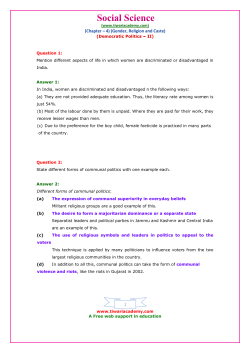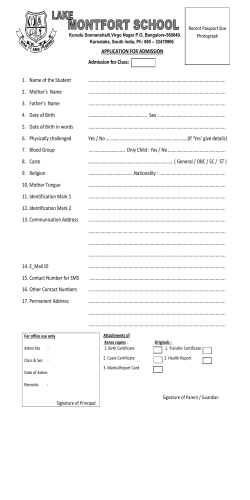
Intersectionality - No Country for Women
Intersectionality Intersectionality refers to the fact that social identity structures interact to create life experiences. This reiterates the idea that the self is heavily influenced by social systems, which intersect with each other. Which means that: if you are poor and a woman, the poverty and your womanhood interact to create your life experiences. For example: you might be more likely to be sexually assaulted at night, because you were forced to work late in your employer’s house and you cannot afford a car to drop you home, and because women are more likely to be sexually assaulted. The various factors that make up your identity – what class you belong to, what caste you belong to, what gender you identify with, how you define your sexuality, what religion you practice, and even where you live – interact with one another to shape your experiences. Imagine your identity as different interlocking structures that work together, instead of different axes that operate independently of each other. Class A class refers to people who broadly have the same levels of wealth (and correspondingly, influence and status). People who belong to the same class generally share economic interests, and these interests can conflict with those that belong to a different class. So, for example, a poor labourer is interested in receiving higher wages, while her contractor is interested in making a profit on the building. Caste Ambedkar’s definition of caste was: “a system of graded inequality in which castes are arranged according to an ascending scale of reverence and a descending scale of contempt .” As you go up the caste system, the power and status of a caste group increases ; and as you go down , the contempt increases as lower castes have no power, are of low status and are considered to be dirty and polluting . The way in which this manifests was, for instance, elaborate rules governing the separation between high and low castes. Public spaces were divided in a way that access to certain streets were barred to lower castes, and in Kerala, lower castes were even required to observe a distance from Brahmins so that even their shadow did not fall upon them. If we were to think that this form of segregation has no place in modern India, think again – implicit forms of segregation by caste still continue to exist, with gated communities being built only for Brahmins (such as the Vedic Agraharam gated community being built near the Devanahalli Airport) and with certain landlords refusing to rent their houses to tenants who consume meat. The consequences of caste structures also have a great deal to do with class – the lower the caste is, the more they are barred from material resources and from sources of knowledge, which means that they tend to be proportionally poorer and without the means to achieve social mobility. Geopolitical location The area that you live in is both affected by the geographical location of the place, but also the politics that surround it. For example, if you are a poor woman living in a drought-affected area, you may have to walk longer distances to fetch water for your family. (That’s an intersection of class, geography and gender!) It is also relevant whether or not you live in an urban or a rural area – research by Pew indicates that urban Indians are twice as wealthy as rural Indians (a monthly per capita expenditure of 1773 rupees as compared to 901 rupees). The political situation in the area where you live is relevant too – so if you are a woman living in Kashmir, you are more likely than a woman living in Bangalore to be raped by an Indian army or a paramilitary officer (look up the Kunan Poshpora incident) , and you are also likelier to have your movements restricted by a curfew. Religion The religion that you practice, or the religious community that you are born into, has a great impact on the sorts of experiences that you are likelier to have. In India, this often relates closely to caste and class (as you can be a Dalit Muslim or Christian as well). To make this point more tangible, a World Bank policy research paper by Panagariya and Mukim indicate that: Hindus in India account for 82% of the population, Muslims in India account for 12.8% of the population, Christians at 2.3% and Sikhs at 1.7%. But on average, Muslims – especially in urban India – experience a much higher incidence of poverty, where 34% are under the poverty line as compared to 19% of Hindus. According to other research, Muslims spend on average only 32.7 rupees a day, while Sikhs spend 55.3 rupees, Christians 51.4 rupees, and Hindus 37.5 rupees. It is important to keep in mind the total proportion of the population these groups constitute when reading the statistics: data for Sikhs could be skewed, for instance, as they represent such a small percentage of the total population. Besides, your religion plays a major role in conjunction with geopolitical location and gender. If you are a woman in an area where there is ongoing communal rioting (such as in Godhra or Muzaffarnagar), your religion can dictate the sexual assault you may endure. Gender Gender has to do with what gender you identify with – whether you identify as male, female, trans* or genderqueer. You may be cis – which means that you identify with the sex you were assigned with at birth (so if you were assigned male at birth based on your genitalia, and you identify as a male, you are a cis male .) Or, you could be trans* – which means that you do not identify with the gender you were assigned at birth, and either identify with the opposite gender (so, a trans* man would be a man who was assigned female at birth) or a person that does not identify with the gender binary at all (which is similar to being genderqueer ). Your gender does dictate your life experiences – if you are trans*, you are disproportionately subject to police violence, violent assault and a lack of medical care, a lack of access to education or employment, and social exclusion. If you are a cis woman, you are disproportionately subject, compared to cis men to sexual assault, rape and lower wages at work. Sexuality Sexuality has to do with the gender that you are sexually attracted to (or not attracted to) – you can be asexual (which means you aren’t sexually attracted to any gender), or you could be bisexual, gay, lesbian or pansexual. Your sexuality too determines your range of life experiences – for instance, if you are a poor gay man, you are likelier to not be able to afford the privacy of a home and thus likelier to bear the brunt of the section 377 offence which criminalises homosexual behaviour. Similarly, if you are a lesbian or bisexual woman, you may face social stigma from traditional families or social circles, and legal barriers. Race Race is a social category that defines people on the basis of their ethnicity or race, and racism exists when one dominant group exercises its power over a less-dominant group. Racism in India is best visible when exercised against black people ( for example, Somnath Bharti led a midnight raid against Ugandan, Nigerian and Congolese women in the Khirkee Extension of Delhi, and proceeded to harass and abuse them while claiming they were involved in a “drug and sex” racket – which displays intersections of gender, class and race!) and against people from the North-Eastern states of India (such as the 2012 exodus of Northeastern people from Bangalore in the wake of threatening rumours that they would be targeted in retaliation for communal violence in their home states, and the death of Nido Taniam in Delhi which sparked an outcry against racism earlier this year). These categories operate in infinite combinations to influence the sort of life you will probably live, and the sorts of experiences you are likelier to have. What does this have to do with rape? We’ve already discussed how some of these categories work together in modern India. They operate in infinite combinations to disadvantage and privilege different groups of people – especially given how interlinked caste and class and gender are; and how interlinked race and gender and class are; how interlinked religion and geopolitical location and class can be. When we add in conversations about gender and rape as a disciplining tool, how rape operates as a tool of power to subdue those that are seen to transgress social norms, the value of intersectionality becomes more clear in understanding how rape works and who bears the brunt of rape culture in modern India.
© Copyright 2025










